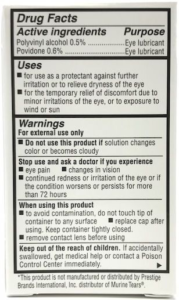Introduction

Dry eye syndrome is a common condition that affects millions of people worldwide. Symptoms of dry eye syndrome include burning, itching, and redness in the eyes. It can be caused by a number of factors, including age, hormonal changes, certain medications, and prolonged use of electronic devices. The discomfort caused by dry eye syndrome can make daily activities, such as reading and working on a computer, difficult and painful. Fortunately, there is a simple solution to help relieve these symptoms: artificial tears.
Artificial tears are eye drops that are designed to mimic the natural tears in your eyes. They come in different forms, including gels, ointments, and sprays, and can help to soothe and moisturize the eye, providing relief from dry eye syndrome symptoms. In this blog post, we’ll take a deep dive into artificial tears, including the different types of artificial tears available, the ingredients they contain, and how they help physiologically. By the end of this post, you will have a better understanding of how artificial tears can help improve your eye health and quality of life.
Types of Artificial Tears

One of the first things to consider when choosing artificial tears is the viscosity of the product. Artificial tears come in three main viscosities: thin, medium, and thick. Each viscosity offers different benefits and drawbacks, so it’s important to choose the one that’s right for you.
Thin artificial tears are designed to mimic the natural flow of tears. They tend to be the quickest-absorbing and longest-lasting of the three viscosities, but may not provide as much relief as thicker options. On the other hand, thick artificial tears are designed to stay in the eye longer and provide more lubrication, but may be more difficult to spread and take longer to absorb. Medium viscosity artificial tears are a good compromise between thin and thick options, providing a balance of quick absorption and long-lasting relief.
Examples of different brands of artificial tears with varying viscosities include:
- Thin: Refresh Tears, TheraTears Liquid Gel
- Medium: Systane Balance, Blink Tears
- Thick: GenTeal Gel, Refresh Plus
When selecting the best artificial tear for you, it’s important to consider your individual needs and speak with an ophthalmologist for personalized recommendations.
Ingredients of Artificial Tears

Artificial tears are made up of a variety of ingredients, each with its own specific function. Some of the most common ingredients found in artificial tears include:
- Electrolytes: help to balance the salt content of tears and maintain eye hydration
- Hyaluronic acid: a natural substance found in the body that acts as a lubricant
- Carbomers: thickening agents that help to provide long-lasting relief
- Glycerin: a moisturizing ingredient that helps to hydrate the eye
- Propylene glycol: helps to preserve the product and keep it fresh
It’s important to understand the ingredients in your artificial tears, as some individuals may have allergies or sensitivities to certain ingredients. Additionally, some artificial tears contain preservatives, which can cause irritation for some individuals. If you experience any discomfort or side effects after using artificial tears, it’s important to speak with an ophthalmologist.
When selecting artificial tears, it’s a good idea to look for products that are free of preservatives, or contain only a minimal amount, to reduce the risk of eye irritation. Additionally, many brands offer preservative-free, single-use vials, which can be a good option for those who are sensitive to preservatives.
How Artificial Tears Work
Artificial tears work by mimicking the natural tears in your eyes and providing lubrication, hydration, and relief from dry eye syndrome symptoms. But how exactly do they work on a physiological level?

Think of your eyes as a well-oiled machine. Natural tears are essential for keeping the eyes lubricated, reducing friction, and maintaining the health of the eye’s surface. When the eyes become dry, the surface becomes irritated and inflamed, causing symptoms such as burning, itching, and redness. Artificial tears help to restore the balance of the tear film and provide relief from these symptoms.
By adding additional moisture to the eye, artificial tears can help to keep the eye hydrated, reducing friction and discomfort. Additionally, some artificial tears contain ingredients, such as electrolytes and hyaluronic acid, that help to support the overall health of the eye and maintain the balance of the tear film.
In summary, artificial tears provide a simple and effective solution for individuals who suffer from dry eye syndrome. Whether you choose thin, medium, or thick viscosity artificial tears, or opt for preservative-free options, it’s important to speak with an ophthalmologist to determine the best solution for your individual needs. With regular use, artificial tears can help to improve the health of your eyes and provide relief from the symptoms of dry eye syndrome.
Conclusion
Artificial tears are a crucial tool for individuals who suffer from dry eye syndrome. With a variety of viscosities, ingredients, and options available, it’s important to understand the pros and cons of each in order to make an informed decision.
By selecting the right viscosity, understanding the ingredients, and using artificial tears regularly, you can help to improve the health of your eyes and provide relief from the symptoms of dry eye syndrome. If you experience any discomfort or side effects after using artificial tears, it’s important to speak with an ophthalmologist for personalized recommendations.
In conclusion, artificial tears are an essential part of maintaining the health of your eyes and providing relief from dry eye syndrome. Whether you choose thin, medium, or thick viscosity artificial tears, or opt for preservative-free options, it’s important to select the right product for your individual needs and use it as directed. With regular use, artificial tears can help to improve the health of your eyes and provide the relief you need.